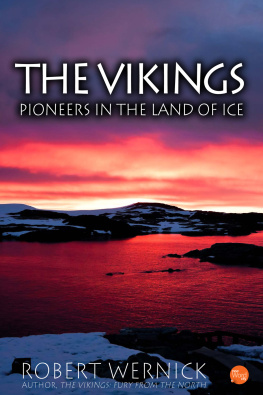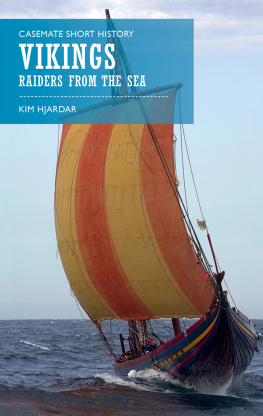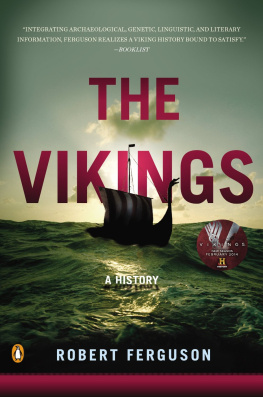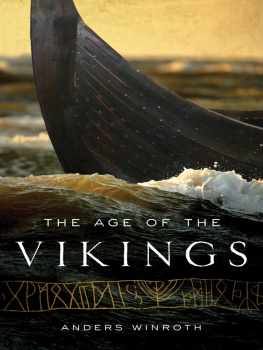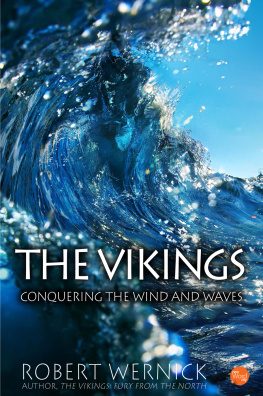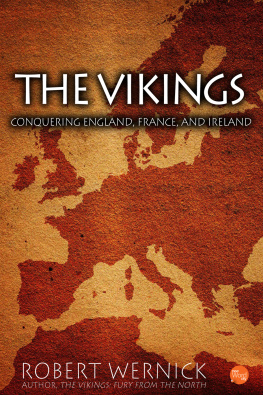His name was Naddod and, for exploits unrecorded but doubtless rude, he was known as a vikingr mikill - a Viking of note. By about 860 A.D., however, his violent presence was no longer welcome in his native Norway, and, in the words of a chronicler, Naddod with a few companions went off to make a home for himself in the Faroes for the good reason that he had nowhere else where he would be safe.
Thanks partly to Naddod, the barren, wind-swept Faroe Islands northwest of the Shetlands would one day become vitally important as a navigational turnoff point for Viking voyages of exploration and settlement in faraway lands. But now the tiny chain served only as a lair for others of Naddods ilk, Norse marauders who occupied their energies raiding Ireland and Scotland to the southeast.
On the way to this place of refuge, Naddod was caught in a terrible storm and, although his square-cut sail ordinarily could hold the ships curved prow on a desired heading, it was no match for a North Atlantic gale. Naddod was blown far off course - as it turned out, some 240 miles northwest of the Faroes. His landfall came on a forbidding coast, riven by swollen rivers and dominated by ice-encrusted mountains. Naddod and his men climbed to a summit and gazed out at the contorted wasteland for some indication of human habitation. But they saw never a sign, reports the chronicler. As they sailed away, shaping a course to the Faroes, heavy snow began to fall, leading Naddod to call the place Snowland.
And that is all the chronicler has to say about Naddod, the exiled Viking - presumably because he did nothing further of note.
At about the same time and by similar accident, another Norse rover reached that same hostile shore. He was a Swede named Gardar Svavarsson, who was sailing for the Hebrides when a storm struck him in the Pentland Firth, the narrow sea passage between the Orkneys and the mainland of Scotland. The storm carried him far westward to a hook-shaped promontory - now known as the East Horn - about fifty miles south of Naddods landfall.
But unlike Naddod, Gardar and his crew did not, after making a brief inspection, turn back. Whether seeking safe shelter or driven by the compulsions of a true explorer, Gardar steered southwest, hugging a ragged coastline and passing a wall of ice looming 5,000 feet high and stretching more than fifty miles from east to west at the terminus of a great glacier. He groped along the southern shore, virtually treeless, harborless, and desolate. He came within sight of twin volcanoes, monsters that breathed smoke and flame, causing the earth to tremble and the sea to roil, siring vast lava fields where thousands of snow-white sea birds nested amid the hardened black and twisted rock formations. Bearing northwest with the curve of the coast, Gardar threaded between the mainland and a group of islands whose dark, brooding cliffs would within a few years take a morbid place in the regions lore.
Rounding a peninsula that extended due west thirty miles from the mainland, Gardar passed the largest and best harbor in all the land. He may not even have seen it, for it was later to be named Reykjavik - meaning Smoky Bay - and it was often misted over by the vapors from a witchs brew of surrounding geysers, steaming springs, and boiling mud holes.
Gardar pointed his prow to the northwest and sailed across a bay sixty miles wide, its waters gleaming in reflection of the surrounding snow-crowned mountains. The little Viking vessel crossed and perhaps prowled into the mouth of the vast fjord, where the profusion of rock islets and swirling currents reminded Gardar of home. The ship then clawed around the contorted fingers of a northwest peninsula and sailed back east along a relatively benign shoreline, broken by fjords that offered haven and by valleys green with grass.
Gardar passed them all by. Summer was ending and the hour was fast approaching when he must beach his ship for winter. Yet evidently within him was an urge to press on, to see what lay around the next bend, to explore beyond the next promontory. At last, arctic blasts told him he must stop. One of the least hospitable places along the northern coast, it was to be known as Skjalfandi, or the Trembler, for its proximity to a volcanic area. There, on a cliff above a bay that lay open to the arctic ice floes, Gardar built a hut for himself and his weary crew.
Winter can only have been wretched for these Viking explorers. The chronicles, perhaps mercifully, do not go into it. In any case, at the first sign of a fair spring breeze, Gardar put back to sea, departing so hastily that he failed to search for and find a crew member named Nattfari, along with a slave and a bondwoman who had become separated from the main party. (Somehow Nattfari survived, for his name is mentioned in the chronicles as an early settler; what befell the other two is unknown.) Gardar now sailed northeast around the Melrakkasletta headlands, then generally south and east back to his starting point at the East Horn. He had followed a coastline that, with its countless deep indentations, measured no fewer than 3,700 miles. Gardar apparently liked some of what he had seen - at least to the point of naming the vast, strange island he had explored after himself: Gardarsholm.
In such Scandinavian trading towns as Birka, Hedeby, and Skiringssal, in the expatriate Viking communities of Ireland and Scotland, at raiding bases in the Faroes, Orkneys, and Shetlands, wherever Norsemen gathered to boast of high adventure, word of the discoveries of Naddod and Gardar spread. Before long, possibly within a year or two, another seafarer set forth. Like Naddod, Flki Vilgerdarson was a Norwegian vikingr mikill. Unlike either Naddod or Gardar, Flki purposely set his red-and-white striped sail for the new-found western island - evidently intending to settle there, for he had loaded cattle and family members aboard his ship.
Flkis route set a pattern for future voyages: Sailing from southwest Norway, he first landed at the Shetlands (where, under circumstances now unknown, a daughter drowned), then steered west and slightly north for nearly 200 miles to the Faroes (where another daughter was married). These stops behind him, Flki headed for the island of ice and fire, nearly 240 miles to the northwest. Perhaps because Naddod and Gardar had been understandably fuzzy about directions, Flki had on board some navigational aids once embarked by the Biblical Noah - three birds. In this case, they were large ravens, and when released from their cages, they could be seen in silhouette against the pale sky and followed for miles as they flew presumably toward the nearest land.
Before departing, Flki had taken the precaution of making a great sacrifice - the accounts do not relate whether man or beast - to the gods so they would smile on his winged guides. Now, out of sight of the Faroes, Flki released his first raven, which soared into the sky, took its sightings, and set a straight course for the Faroes. Undaunted, Flki sailed on, released the second raven and watched bemusedly as it flapped about in a few circles, then landed on the ship. Onward forged Flki, his faith still with his birds. And his trust was amply rewarded: The third raven flew west, leading Flki - henceforth to be known as Raven Flki - to the East Horn of the western island at almost the same spot where Gardar the Swede had begun his circumnavigation.
Raven Flki, his men, his cattle, and what remained of his family followed Gardars route around the island, marveling at the same sights, until they came to a great fjord in the northwest, later to be called Breidafjord. There they decided to settle.
Alas, Raven Flki was a better sailor than a settler. The fjord was alive with salmon and cod and seal, the grass grew lush along its shores, and, while his cattle grew fat, Raven Flki fished and hunted to his hearts content - all the while neglecting to put up hay for winter. As a result of his negligence, his livestock perished before spring. Raven Flki bitterly blamed the land for his own imprudence. Then he packed up, and, late that second summer, he sailed for Norway. But dreadful southwesterly gales howled across the waters for much of the time, and Raven Flki could not get around the most southerly headland. He and his men had to spend another awful winter shivering in a primitive camp. Not until the next summer did they pass the guardian headland and reach home.
Next page
